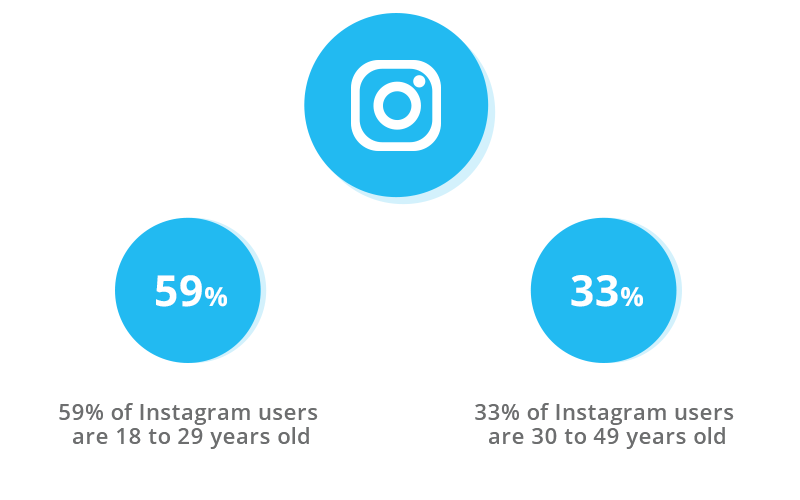4 social media platforms for sports video content in 2018
Within the sports industry, everyone from rights holders to broadcasters and sponsors is focusing attention on Facebook, YouTube and Twitter. Justifiably so, as the big three are market leading social media platforms attracting huge audiences, and natural places to find the best streaming and hosting features.
But there’s life beyond these three platforms. Why not consider a different social channel as an ace up your sleeve? Before we delve in to which channels you might choose, let’s explore some background.
The rise of new channels and video
While traditional television has been at the fore of mass sports coverage for years, the world continues to change drastically. The flexibility of the internet has caused havoc in the stiff world of linear TV in recent years. Social media has only deepened a sense of impending crisis.
You may also be interested in the essential read if you’ve ever wondered how to make traditional TV cool again!
One of the latest trends on social media has been the shift towards short, clipped videos – a major point of difference when compared to traditional TV’s long-form formats. It all started with Snapchat, then Instagram and their stories. Nowadays, each social platform favours video – it’s the most engaging and most consumed[1] type of content. So, even if TV is not now number one, video definitely is!
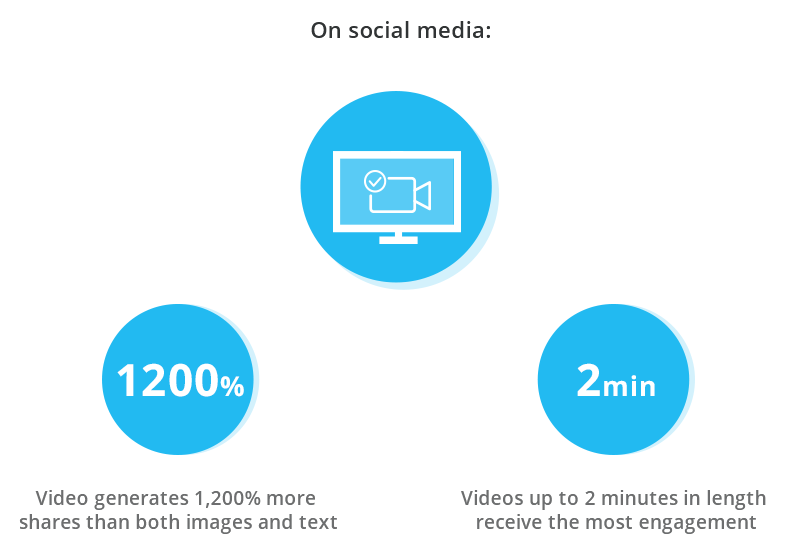
Let’s see what social media platforms are worth checking and considering as a home for your sports video content and more.
Snap that authenticity!
Yes, yes! We all know that Snapchat is extremely popular and that it’s a medium mostly for Gen Zers. While not every brand needs to be there, you should consider it as an option if you’re looking to reach younger audiences.

Snapchat is remarkably well suited to sports. Short, dynamic and unedited sports clips are perfect for this platform that favours ephemeral video content. Short video clips give Snapchat a feeling of freshness and authenticity, which might be easily killed off by the perfect-looking, over-produced clips that you see on Facebook or Twitter.
If you want to try something really cool, check Snapchat Spectacles – digital glasses that can record videos for Snapchat, but also publish them on Facebook, Instagram and YouTube. How cool is that! Check it out yourself:
Insta-everything
You may view Instagram as a place for food and holiday photos and that’s… correct! But this doesn’t mean that you shouldn’t try to bring some of your cool sports videos over to the platform. Especially when Instagram is able to attract a greater mix of audiences that you might want to connect with.
Another positive aspect to Instagram is its own Snapchat-like feature – Instagram Stories – that heavily involves video. While it is Snapchat that brought the video-story format to life, it’s Instagram’s Stories that get better results. Why? Because while Snapchat has die-hard fans that are using the platform for better or worse; Instagram has a couple of huge advantages in a bigger user base and Facebook integration under the hood.
Furthermore, Instagram Stories and its features present videos very professionally, making them look slicker (if that’s what you want). Alongside Stories, you can also publish a varied mix of pictures, raw and spontaneous videos, and professionally produced clips. It’s your call!
Giphy, because we all love GIFs
Not exactly a social network, Giphy is an online database and search engine for animated GIFs. It’s used in one of two ways: users can search for cool animations in an online library, or through third party apps like Facebook Messenger for example.

Giphy is going from strength to strength, recently signing partnerships with big brands to promote content. These partnerships mean that users can now find and use animated GIFs created by Calvin Klein, Disney, General Electric, NASA or Paramount Pictures. As part of the deal, companies get their own profiles on Giphy, which users can search to look for the best GIFs.
Giphy will soon start rolling out sponsored GIFs. According to Techcrunch[5], brands will have the chance to buy a presence in Giphy’s top search results with their branded animations. If you’re a sports brand or broadcaster, this sounds pretty tempting, right?
Tumblr for the brave
The truth is that not every brand fits Tumblr and its spirit. Some say that this pretty well-worn platform is not a good place for brands to be. The reality is complex.
However, Tumblr can be great if your brand has a young audience made up of people who don’t take things too seriously, have a quirky sense of humour and are really open minded.
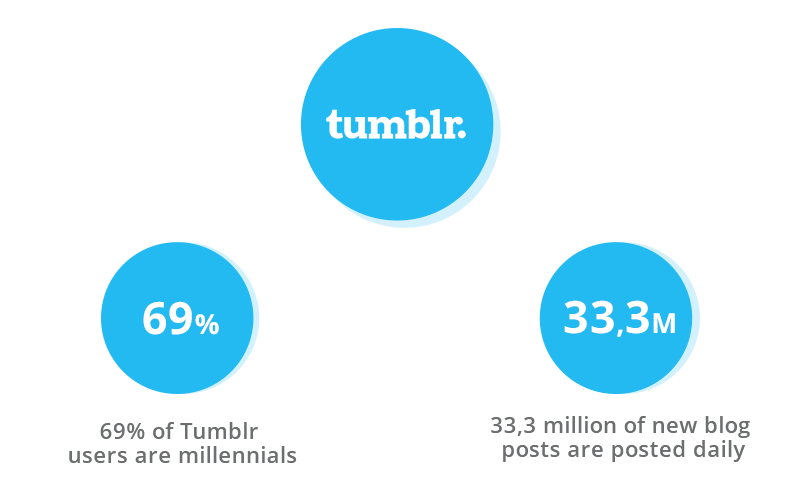
One of the advantages of Tumblr is how it can be used in many different ways. It’s a good for pictures, GIFs and videos, while you can also use it as an effective microblogging platform too. However, most brands keep it strictly for visual content, which can work really well for sports. Check out Vans for compelling extreme sports shots.
Explore lesser known territories
While it’s important to maintain your presence on mainstream social media networks, you should also pay attention to other platforms. Lesser known platforms can offer something different and deliver good gains, such as better visibility when targeting younger demographic groups, like Gen Zers through Snapchat for example.
Besides, with the popularity of short video clips and animated GIFs at a colossal level, it seems a good time to take advantage of the social platforms where these formats are heavily consumed.
Your essential read if you’ve ever wondered how to make traditional TV cool again!
In the US, adults are spending more and more time with different kinds of digital media[1], while their attention is also shifting from traditional TV to PCs, and smartphones and tablets connected to the web.
What’s interesting is that while there is an enormous variety of traditionally broadcast TV channels to choose from (a monthly average of 206 channels according to Nielsen research), US adults only actively watch 20 of them[2]. In other Nielsen data for US adults, while TV still rules people are using a broader range of devices for home entertainment, with apps and the web now hot on the heels of TV. The total time spent on other devices now outweighs time spent watching traditional TV.
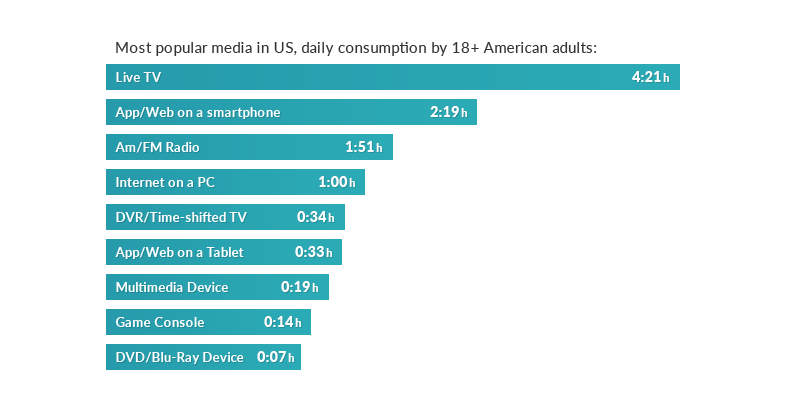
If you look at the behaviour of younger viewers in particular, what’s evident is that Generation Z (12-20 year olds) consume the smallest amount of traditional TV, either when live or time shifted/recorded. Arguably, this is the effect of a new and younger audience becoming bored (or simply not accustomed to) traditional TV’s linear approach, which might be a challenging argument to accept if you work in broadcast TV.
To help you to understand, let’s look at this analogy. Nowadays, traditional TV is like a middle-aged guy trying to gain popularity on Snapchat – the technology feels the same, the rules are clear, but somehow it simply doesn’t work for him. What he says and does is simply not attractive enough for the audience on that platform. (Believe me, I feel like this guy at times as I don’t always understand the buzz surrounding Snapchat.)
Back in the broadcasting world, you may be more than conscious that new ways of consuming media are coming. You might feel they’re already here. Yet, with huge resources, varied schedules and all the broadcasting technology at your disposal, perhaps you’re still left wondering why traditional TV isn’t as attractive as it was? Perhaps you can’t quite put your finger on why this is the case.
Let’s take a closer look at some of the opportunities and threats below.
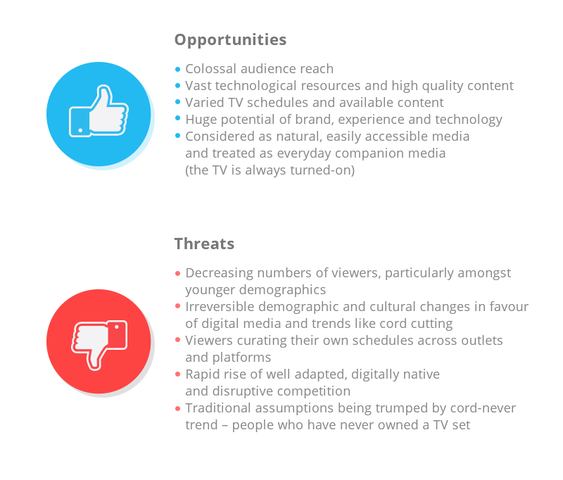
What’s common amongst the above threats is the impact of the internet and the smartphone. Viewers now have more flexibility – they can watch and interact with digital, web TV and OTTs in any manner they like, where and when they want, and on the device of their choosing.
Why should viewers miss the ol’ set-top box? So, is this the end of linear TV as we know it? It’s too early to jump to this kind of conclusion. For sure, there are now many more options to traditional TV and improvements that linear broadcasters should make to stay in the game.
Let’s dive in and check out six ways you can sharpen your focus to stay alive in this fast-paced, digital-first world.
- Make the web your friend and ally
- Use your TV brand as leverage
- Your experience is your advantage
- Retain your loyal viewers
- Work across platforms
- Conversations – it takes (at least) two to tango!
First things first, if you haven’t done so already, make your brand more visible online by expanding your social media presence. Take time to reconsider your options, making an audit of your efforts to date to identify what’s worked and what hasn’t.
When relaunching your social media presence, have a video content strategy in place that puts you in a position to start streaming and producing videos for social channels. Streams and social videos make for highly engaging web content and, as a broadcaster, you are ideally placed to create a constant stream of such content. To do so, choose social video production tools and platforms that will fit your needs, and ones that will enable you to stream and produce videos from live content and any archival content you want to use.

Live streams and videos are undoubtedly the most engaging types of content. When checking Facebook streaming results for one of our Tellyo clients, we learned that it is possible to create up to 400 interactions per 1,000 fans with live video, while images were able to reach only 6 interactions per 1,000. For further interesting stats, check out the case studies section on our website.
Having a strong and recognisable brand is unbelievably helpful online – it will help you to stand out. If your logo is well known, you should remember to place it on your video content, so that when this spreads around the internet you get the brand recognition you deserve. With a little bit of luck, many viewers will trace your quality content back to your channel or Facebook page.
Being experienced with video production and everything broadcasting related is a huge advantage over your competitors. Being able to create TV-grade video content, while having an experienced team and professional equipment are all strong assets. However, these assets aren’t enough to be successful on the web and in the social media, but they will help a lot. You can always talk to us here at Tellyo about how to combine your experience with an advanced, social video production platform such as ours.
Have you ever heard of the Pareto principle[4]? Better known as the 80/20 rule which states that 80% of the effects come from 20% of the causes. Translating this into broadcast language – it means that 20% of your audience is responsible for 80% of your views. Therefore, if you want to be successful in social media, play to your core audience. Let them know that soon they will be able to watch their favourite shows and events via other media as well.
Remember that social media isn’t monolithic – it’s decentralised and each platform has its own properties. You shouldn’t copy and paste your strategy from one channel to another. For example, if you decide to stream content then use YouTube, Facebook or Twitter, but only YouTube will be a good place as a platform to host clips for a longer period. Facebook will give you a big audience and visibility initially, but people will not find your videos once they vanish from timelines.
Your audience has a voice, and it will use it. In comments, emails and chats, they will use each possible channel to give you their opinion about your content. And that’s a good thing – a gold mine of interactions and engagement to treasure. You should work hard to maintain these conversations. Be active: answer questions and ask for opinions.
It’s too early to abandon ship
Traditional, linear TV still has a lot to offer audiences. But the TV landscape in the next 5-10 years will be dramatically different to what we have now.
In the meantime, there is likely to be many more advances and disruptive changes. Now is your chance to decide whether you want to be part of it or not.
Make that leap and get your live video content onto social media
One of humankind’s greatest ever achievements – landing on the moon – was widely televised. It was a giant leap for humankind. But how will we all tune in when someone first walks on Mars? Most likely live via social media and on different devices – from smartphones to tablets and VRs.
But before we go that far, let’s get back to Earth for a second, and let the numbers talk!
The rise of live video content online
By 2019 video will be responsible for 80% of global internet traffic. Live video alone will consume 13% of internet video traffic by 2021. At the same time, in the United States, TV audiences dropped by 11% between 2010 and 2016.
Most predictions suggest a continued decline in traditional TV viewing, just as new viewing habits appear to be unstoppable. Audiences increasingly look for live video content online.
But while live video on social media is already huge, it’s not even close to saturation. With millennials and generation Z at the helm, the future of live video content looks bright and promising. Here are some steps you can take to get your live video onto social media.
Create a multi-channel strategy
The very first step to jumping on the social video bandwagon is to create a multi-channel strategy for your brand, incorporating the right channels for you.
When it comes to live video, Facebook is number one among social networks. It holds 45% of the social media streaming market share. Without doubt, Facebook is going to be a major platform for social media broadcasters for a long time.
“People spend more than 3x more time watching a Facebook Live video on average compared to a video that’s no longer live”[1]
The second most popular platform for live video content is YouTube, with 44% of video market share. It is rightly a natural place for live content, so when planning your presence on social media, don’t forget to consider Google’s flagship video platform.
Other significant social media broadcasting players are Instagram and Snapchat with 28% and 19% market share respectively.
Go multi-channel for the win
The importance of social media doesn’t mean it’s time to simply ditch traditional broadcasting platforms. It’s not about moving your business to the internet entirely. Rather, it’s about implementing a multi-channel strategy as soon as possible. One that will enable you to capture and engage with the huge audiences that exist online.
What the stats tell us, is that demand is huge. This is partly due to people’s preference for watching videos over reading text online (nearly two thirds of people on the internet prefer it this way). Other sources also point out that if you consider all videos on Facebook, including live broadcasts, that these are being viewed around 64 billion times daily! That’s a staggering amount of views, right?
What these stats mean is that the internet is full of people eager to watch live video broadcasts, as far as it’s related to their passions and interests.
Keep an eye on this fast-evolving environment
Today the MVPs may well be Facebook, YouTube, Instagram and Snapchat. But tomorrow – who knows?
One thing is for sure. If you can adapt the channels you use to get live video to your audiences as they want it, then you will succeed when it comes to social media.
As you can see, the above numbers speak for themselves. So why not make that leap and get your live video onto social media today!
[1] https://newsroom.fb.com/news/2016/03/news-feed-fyi-taking-into-account-live-video-when-ranking-feed/



